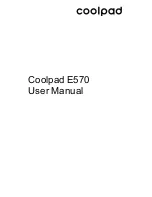
Confidential
USERS MANUAL
18(158)
Document number
Revision
1/198 17-4/FCP 101 3045 Uen
D
Call Forwarding.
Permits the called module to have the network send incoming calls to a desired phone
number.
Call Waiting.
Permits the module to be notified of an incoming call during an active call. For example, if
the module is engaged in an active call, the module can accept, reject or ignore the incoming call.
3-Party
Conference Calls.
Permits the module to maintain simultaneous communication with more than
one party.
Voice Mail.
Permits the module to activate/deactivate voice mail. In addition, the module can retrieve
voice mail held for the user.
Note: Some subscriber call features, such as Call Forwarding and Call Waiting, may vary depending on your
service provider’s network. Subscriber call features are activated and deactivated via the ATD command
using specific codes. These codes might vary depending on the service provider. Consult your service
provider for additional information.
3.3
Over The Air Service Provisioning (OTA)
The CM52 supports TIA/EIA/IS-683-A: Over-the-Air Service Provisioning of Mobile Stations in Spread
Spectrum Systems.
Over the air programming is a mechanism that enables service providers to program mobile equipment (ME)
to match their network requirements. For the CM52, OTA is typically used to update NAM values, download a
PRL, update the A-key, etc.
OTA will not write the updates until all desired data has been downloaded into the module. This prevents
incomplete or inconsistent data from being written when the connection is prematurely terminated and OTA did
not complete all the programming.
OTA has two variants: OTA Service Provisioning (OTASP) and OTA Parameter Administration (OTAPA).
OTASP is used to initially program the ME. OTASP is initiated from the ME. OTAPA is used to apply updates
to an ME that is already provisioned. OTAPA is initiated from the service provider. OTAPA is transparent to the
user/application of the ME. If an OTAPA session is in progress and an outgoing call is placed, OTAPA will
continue to program the phone in the background.
The progress of the OTA programming is reported by using the *EUNSOL unsolicited responses. See the
AT*EUNSOL command for more information.
Note:
the CM52 provides more status information than some Carriers feel should be provided to
handset users. It is left to the host application to determine what status data to provide to the user,
keeping the Carrier’s requirements in mind.
Initiating OTASP is done via a call to *228
xx
; where
xx
indicates the frequency range:
xx
Frequency
00 800
MHz,
A-Band
01 800
MHz,
B-Band
02
1.8 GHz, A Block
03
1.8 GHz, B Block
04
1.8 GHz, C Block
05
1.8 GHz, D Block
06
1.8 GHz, E Block
07
1.8 GHz, F Block
















































